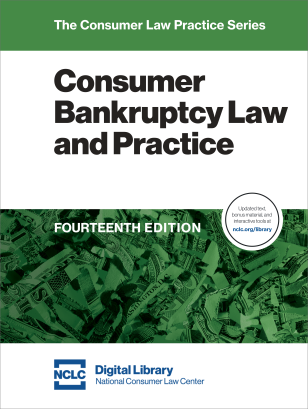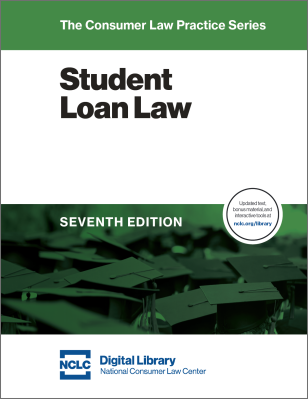This article details three of the most significant recent changes to consumer bankruptcy law. New federal legislation provides added bankruptcy protections for veterans, current servicemembers, and their dependents when filing either a chapter 7 or chapter 13 bankruptcy. Effective December 1, a number of changes have been made to the Federal Rules of Bankruptcy Procedure.
Perhaps of most general interest, a must-read October 22, 2019, Fifth Circuit decision indicates how many private student loans can now be discharged in bankruptcy. This is the first circuit court ruling exploring this approach to discharging private student loans, and it holds in favor of the debtor.
Of added note to bankruptcy practitioners, NCLC this November released the twelfth edition of Consumer Bankruptcy Law and Practice, the definitive consumer bankruptcy treatise available in print and digitally. The two volume edition is updated with: all recent significant decisions; sample completed official forms for both chapter 7 and 13 cases, with annotations; over 180 sample bankruptcy pleadings in MS Word format; the new bankruptcy rules, forms, and Code provisions for 2020, with updated dollar amounts; and a number of revised practice tools.
New Bankruptcy Legislation Protecting Veterans in Chapter 7 and Chapter 13
The Honoring American Veterans in Extreme Need Act of 2019 (HAVEN Act), adding 11 U.S.C. § 101(10A)(B)(ii)(IV), effective August 23, 2019, provides new rights for veterans, current servicemembers, and their dependents filing either a chapter 7 or a chapter 13 bankruptcy. A detailed analysis of the new legislation is publicly available at www.nclc.org/veterans.
The HAVEN Act loosens eligibility for veterans to file chapter 7 bankruptcies. Previously, the determination of current monthly income included a veteran’s VA benefits, meaning that such benefits could increase income enough to trigger the imposition of the bankruptcy means test and the presumption of abuse, which in certain cases could result in the case’s dismissal. See NCLC’s Consumer Bankruptcy Law and Practice § 13.4.5. The HAVEN Act deducts most VA benefits from current monthly income, meaning many veterans and servicemembers will no longer be subject to the means test or that the presumption will be easier to rebut.
The HAVEN Act also reduces the amount veterans and servicemembers must pay unsecured creditors in a chapter 13 filing. Current monthly income is the starting point for disposable income that chapter 13 debtors may be required to pay to their unsecured creditors. See NCLC’s Consumer Bankruptcy Law and Practice § 12.3.4.4.1. Deducting most VA benefits from current monthly income reduces a veteran’s projected disposable income and the amount they must pay to unsecured creditors. Exclusion of VA benefits may also bring the veteran below the applicable state median income level, resulting in only a three year commitment period rather than a five year period, as discussed in NCLC’s Consumer Bankruptcy Law and Practice § 12.3.4.4.6.
How to Take Advantage of the New Protections
The new protections apply to any bankruptcy filed after August 23, 2019, and there is a strong argument that they also apply to any bankruptcy case pending on August 23. See another NCLC article at www.nclc.org/veterans that examines the issue of retroactivity in detail.
To determine if a client’s benefits are eligible to be excluded from the current monthly calculation, look to their award letters, paystubs, and service records to see which benefits they are receiving. In addition, eBenefits and myPay can be used to see which types of benefits they receive.
Once you know which types of benefits your client receives, consult the chart found at www.nclc.org/veterans, that lists and explains excluded benefits. Once you have determined the amount of each excluded benefit, include the amount in the designated spot on Official Form 122A-1 (for chapter 7) or Official Form 122C-1 (for chapter 13). These forms were amended effective October 1, 2019 to account for the HAVEN Act’s passage.
Although it is not clear whether excludable VA benefits need be listed under Schedule 106I, the safest course is to disclose the benefits on Schedule 106I and then deduct them on Schedule 106J.
What Practitioners Need to Know About New Bankruptcy Rules, Effective December 1
The Federal Rules of Bankruptcy Procedure and the official bankruptcy forms have been amended, effective December 1, 2019. For an analysis of all the new rules, reprints of all bankruptcy rules effective December 1, the bankruptcy rule advisory committee notes, and sample completed and annotated official forms for both chapter 7 and chapter 13 cases, see the just-released edition of NCLC’s Consumer Bankruptcy Law and Practice. This article highlights the most important changes.
Request for Postpetition Credit, Rule 4001(c)
Bankruptcy court procedures on obtaining postpetition credit in chapter 13 cases vary widely, as discussed in NCLC’s Consumer Bankruptcy Law and Practice § 12.6.6. Some courts have looked to Bankruptcy Rule 4001(c) for guidance, though this rule did not explicitly state whether it applied in chapter 13 cases. Effective December 1, the rule is amended to provide that subdivision 4001(c) does not apply in chapter 13 cases. The Advisory Committee note states that this “amendment does not speak to the underlying substantive issue of whether the Bankruptcy Code requires or permits a chapter 13 debtor not engaged in business to request approval of postpetition credit.”
The implication of the amendment is that local courts are left to decide, as they have previously, both the substantive and procedural requirements for obtaining credit in chapter 13 cases. Most courts require that before incurring any significant credit that would have an impact on the debtor’s budget, such as a mortgage refinance or car purchase, the debtor must notify the chapter 13 trustee or seek formal court approval. This is often done through motion practice similar to that outlined in Rule 4001(c) or through a motion to amend a confirmed plan. Attorneys must continue to check local court rules and decisions on this issue. Sample forms that can be used are found in NCLC’s Consumer Bankruptcy Law and Practice Appx. G.8, Form 92 and Appx. G.13, Forms 160–164. These forms are also included in MS Word format with the treatise’s digital version, allowing them to be downloaded and edited for use in bankruptcy cases.
Request for Abandonment of Property, Rule 6007(b)
In most consumer bankruptcy cases, all property of the debtor’s estate having little or no nonexempt equity is abandoned, simply by the trustee declining to administer the property and closing the case. This occurs automatically because property that is scheduled and has not been administered is deemed abandoned under Bankruptcy Code § 554(c), as discussed in NCLC’s Consumer Bankruptcy Law and Practice § 3.5.1.
However, there are situations in which the debtor may need to use the property before the case is closed or the trustee may sit on the property, keeping the case open, in hopes of eventually being able to sell it if there is appreciation in value. In such cases the debtor may seek an order under section 554(b) that the property be abandoned by the trustee on the grounds that it would not provide any meaningful distribution to creditors.
Requests by the debtor for abandonment are governed by Bankruptcy Rule 6007(b). While this rule stated that the request must be made by motion, it lacked detail about specific requirements, such as the necessary parties to be served and the deadline for objections. Rule 6007(b) has been amended to require that:
- The motion and any notice of the motion must be served on the trustee, all creditors, and the United States trustee (and any indenture trustees or committees in a chapter 11 case), unless the court directs otherwise. (A sample motion can be found at NCLC’s Consumer Bankruptcy Law and Practice Appx. G.10, Form 112. The form is also included with the treatise’s digital version in MS Word format, allowing it be downloaded and edited for use in bankruptcy cases.
- A party in interest may file and serve an objection to the motion within fourteen days of service or some other time fixed by the court.
- If a timely objection is filed, the court shall set a hearing on notice to the United States trustee and to other entities as the court may direct.
- If the court grants the motion, the order effects the trustee’s abandonment of the property without further notice, unless the court directs otherwise. On this point, the Advisory Committee note states that “the rule clarifies that no further action is necessary to notice or effect the abandonment of property ordered by the court in connection with a motion filed under subdivision (b), unless the court directs otherwise.”
Notice and Service, Rule 9036
Bankruptcy Rule 9036, formerly titled “Electronic Transmission,” provided for limited notice by electronic transmission. The rule has been expanded to permit both notice and service by electronic means. As stated in the Advisory Committee note, “the use and reliability of electronic delivery have increased since the rule was first adopted. The amendments recognize the increased utility of electronic delivery, with appropriate safeguards for parties not filing an appearance in the case through the court’s electronic-filing system.” The electronic-filing system referred in the rule is the Case Management/Electronic Case Files (CM/ECF) case management system used by the Federal Judiciary.
Under amended Rule 9036, whenever a bankruptcy rule requires the sending of a notice or serving of a paper by mail, the clerk, or any other person the court directs, may send the notice or serve the paper on a CM/ECF registered user who has appeared in the case by filing it with the court’s electronic-filing system. Or it may be sent by other electronic means if the person consents to it in writing. In either case, service or notice is complete upon filing or sending.
A court may allow CM/ECF registration only with the court’s permission. Once a party registers, it will be subject to service by filing with CM/ECF unless the court provides otherwise.
Service is not effective if the filer or sender receives notice that it did not reach the person to be served. The rule does not make the court responsible for notifying the filer that an attempted electronic transmission failed. If a filer receives notice that the transmission failed, the filer is responsible for making effective service.
This rule does not apply to any pleading or other paper required to be served in accordance with Rule 7004.
Redaction of Previously Filed Documents, Rule 9037(h)
Bankruptcy Rule 9037 deals generally with privacy protections for filings made with the bankruptcy court. It requires that documents containing personal identifying information be redacted before they are filed with the court, as discussed in NCLC’s Consumer Bankruptcy Law and Practice § 7.1.5. The rule did not address, however, the procedure for correcting a previously filed document that was not properly redacted. New Rule 9037(h) now specifies the steps that must be taken if an entity, either the original filer or anyone else, seeks redaction of a filed document. The entity must:
- File a motion to redact, identifying the proposed redactions;
- Attach to the motion the proposed redacted document;
- Include in the motion the docket or proof-of-claim number of the previously filed document; and
- Serve the motion and attachment on the debtor, debtor’s attorney, trustee (if any), United States trustee, filer of the unredacted document, and any individual whose personal identifying information is to be redacted.
Pending its ruling on the motion, the court must restrict public access to the motion and the unredacted document. If the court grants the motion, the court must docket the redacted document and the restriction on public access to the motion and unredacted document must remain in effect until a further court order. If the court denies the motion, the restriction must be lifted, unless the court orders otherwise.
The Advisory Committee note makes clear that Rule 9037(h)(1) authorizes the court to alter the procedure, and gives a helpful example when the motion is filed by the debtor. The note states that it may be appropriate for the court to relieve the movant of the requirement to attach to the motion the proposed redacted document when, for example, “the movant was not the filer of the unredacted document and does not have access to it.”
As discussed in NCLC’s Consumer Bankruptcy Law and Practice § 7.1.5, parties may be sanctioned for failing to follow the reaction rules. The Advisory Committee note states that the new procedure set out in Rule 9037(h) “does not affect the availability of any remedies that an individual whose personal identifiers are exposed may have against the entity that filed the unredacted document.”
A sample motion for redaction, found in NCLC’s Consumer Bankruptcy Law and Practice Appx. G.11, Form 129, has been updated to reflect the procedure set out in Rule 9037(h). As with all 183 of the Appendix G sample forms, Form 129 is available in MS Word format included with the treatise’s digital version, ready to download and edit.
Key Circuit Court Decision Holds Private Student Loan Can be Discharged
Attorneys should not assume that all of a debtor’s student loans are covered by the discharge exception in Bankruptcy Code § 523(a)(8). Although most federal student loans are nondischargeable, a recent line of cases has found that certain private student loans can be discharged. The Fifth Circuit, the first court of appeals to rule on the issues raised in these cases, has sided with the debtor in a must-read decision for debtors’ attorneys.
In In re Crocker, 941 F.3d 206 (5th Cir. 2019), the two named plaintiffs argued that their student loans (one obtained to pay for tuition and expenses to attend a technical school and the other for a bar examination preparation course) did not fit in any of section 523(a)(8)’s three subsections. Navient conceded that subsection 523(a)(8)(A)(i) did not apply to the loans, which generally protects from discharge loans made or insured by a governmental unit or a nonprofit institution.
Navient also did not take advantage of the exception to discharge added in 2005 as subsection (B) for private student loans, no doubt because it could not prove that the loans were “qualified education loans” under the Internal Revenue Code. IRS Code § 221(d)(1) defines qualified education loans as indebtedness incurred solely to pay qualified higher education expenses and as not including expenses for any other purpose. This is discussed in NCLC’s Student Loan Law § 11.2.3.4.
This left Navient with the sole argument that the loans were nondischargeable under subsection (A)(ii). Added to the Code in 1990, this subsection applies to “an obligation to repay funds received as an educational benefit, scholarship, or stipend.” This benefit repayment language generally applies to certain grants that would not need to be repaid unless the recipient fails to meet specified conditions, such as a requirement that a student practice a profession or trade in a geographic area or serve a designated population.
As discussed in NCLC’s Student Loan Law § 11.2.3.3, a recent line of cases has narrowly construed subsection (A)(ii) and rejected creditor efforts to make it a “catch-all” provision that would include every type of credit transaction that creates an educational benefit for a debtor. Most importantly, these decisions have held that subsection (A)(ii) does not apply to loans.
The Fifth Circuit in Crocker embraced this reasoning in a superb application of statutory construction canons. The Crocker court began by noting that the two subsections that precede and follow subsection (A)(ii) both refer expressly to “loans,” but the word “loan” is conspicuously omitted from subsection (A)(ii). The court then noted that the phrase “an obligation to repay” appears only in subsection (A)(ii) and not in the other subsections. On this point the court stated: “The phrase is superfluous when referring to loans, but it is quite relevant to payments with contingent obligations.” 941 F.3d at 219.
The Crocker court then tackled the remaining language, finding that the word “benefit” is so broad that it should be understood in the context of the complete phrase and the other listed items “scholarship” and “stipend.” The court stated: “One general quality in the relevant phrase is that stipends and scholarships ‘signify granting, not borrowing.’ [citation omitted]. Those grants may be conditional, but satisfaction of the conditions leaves them as grants. The common quality is that scholarships and stipends may not need to be repaid.” Id.
Like a number of other courts in recent opinions, the Fifth Circuit also found that if subsection (A)(ii) applied so broadly as to encompass loans as well, this would render subsections (A)(i) and (B) superfluous. The 2005 amendment creating subsection (B), applicable to private loans, came well after the 1990 amendments that added the language now appearing in subsection (A)(ii). Congress would not have needed to add subsection (B) if subsection (A)(ii) already included all loans of any type: “Under Navient’s interpretation, government loans covered by Subsection (A)(i) and qualified education loans covered by Subsection (B) would also be covered by Subsection (A)(ii), rendering the other subsections serving little purpose. Courts have a ‘duty to give effect, if possible, to every clause and word of a statute.’” 941 F.3d at 220.
Based on this construction of the statute, the court held that the student loans were dischargeable. The debtors were not so fortunate on the other question in the case dealing with the enforcement of the statutory discharge injunction under section 524. The Fifth Circuit held that the discharge may not be enforced by a court in a judicial district different than the district in which the discharge was entered, raising serious questions as to whether a nationwide class in a discharge violation case can be certified. A pending request for rehearing en banc hopefully will be granted and the court will reconsider this part of the decision.




